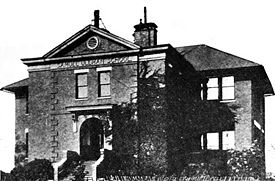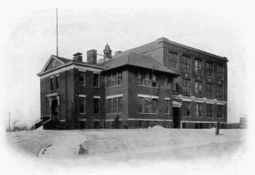Ullman Building: Difference between revisions
No edit summary |
|||
| Line 1: | Line 1: | ||
[[Image:Ullman School 1911.jpg|thumb|right| | [[Image:Ullman School 1911.jpg|thumb|right|275px|The original Ullman School building of 1901]] | ||
The '''Ullman Building''' (formerly the '''Samuel Ullman School''' and '''Samuel Ullman High School''') is a historic [[Birmingham City Schools]] building on [[7th Avenue South]] at [[12th Street South|12th Street]]. Originally part of [[Birmingham City Schools]] system, it was sold to [[UAB]] in [[1970]]. | The '''Ullman Building''' (formerly the '''Samuel Ullman School''' and '''Samuel Ullman High School''') is a historic [[Birmingham City Schools]] building on [[7th Avenue South]] at [[12th Street South|12th Street]]. Originally part of [[Birmingham City Schools]] system, it was sold to [[UAB]] in [[1970]]. | ||
| Line 10: | Line 10: | ||
Notable faculty members at Ullman included [[Birmingham Civil Rights Institute]] founder [[Odessa Woolfolk]] and Reverend [[John Wesley Rice]], father of [[Condoleezza Rice]], who was the school's guidance counselor. Jazz musician [[Wilson Driver]] organized the first Ullman High School Band. | Notable faculty members at Ullman included [[Birmingham Civil Rights Institute]] founder [[Odessa Woolfolk]] and Reverend [[John Wesley Rice]], father of [[Condoleezza Rice]], who was the school's guidance counselor. Jazz musician [[Wilson Driver]] organized the first Ullman High School Band. | ||
[[Image:UllmanHall.jpg|right|thumb|The Ullman building in 2002]] | [[Image:UllmanHall.jpg|right|thumb|225px|The Ullman building in 2002]] | ||
In [[1970]] [[UAB]] began using the former school for its classes. A year later the building was sold to the University and became the home of the [[UAB School of Social and Behavioral Sciences|School of Social and Behavioral Sciences]]. That school was relocated to the newly-constructed [[Heritage Hall]] in January [[2008]]. The new building's name was chosen to honor the heritage of Ullman High School, as well as of its namesake. | In [[1970]] [[UAB]] began using the former school for its classes. A year later the building was sold to the University and became the home of the [[UAB School of Social and Behavioral Sciences|School of Social and Behavioral Sciences]]. That school was relocated to the newly-constructed [[Heritage Hall]] in January [[2008]]. The new building's name was chosen to honor the heritage of Ullman High School, as well as of its namesake. | ||
Revision as of 11:55, 21 April 2011
The Ullman Building (formerly the Samuel Ullman School and Samuel Ullman High School) is a historic Birmingham City Schools building on 7th Avenue South at 12th Street. Originally part of Birmingham City Schools system, it was sold to UAB in 1970.
The Ullman School, a grammar school serving white students, opened in 1901 and was named for Samuel Ullman, a long-serving member of the Birmingham Board of Education. The first principal was Mary N. Dabney. Eleven classrooms were added to the original 4-room unit in 1909.
In 1937 the building became a high school for black students from Southside and Titusville. The high school was greatly enlarged with a new three-story classroom wing in 1957. The new wing obscured the original front facade of the school.
Notable faculty members at Ullman included Birmingham Civil Rights Institute founder Odessa Woolfolk and Reverend John Wesley Rice, father of Condoleezza Rice, who was the school's guidance counselor. Jazz musician Wilson Driver organized the first Ullman High School Band.
In 1970 UAB began using the former school for its classes. A year later the building was sold to the University and became the home of the School of Social and Behavioral Sciences. That school was relocated to the newly-constructed Heritage Hall in January 2008. The new building's name was chosen to honor the heritage of Ullman High School, as well as of its namesake.
UAB has not finalized plans for the historic building. It has been suggested that the 1957 annex might be removed as part of a renovation of the older building.
Notable alumni
- Taylor Weldon Green, educator
- Freeman Hrabowski, President of the University of Maryland, Baltimore County
- Larry Kenon, professional basketball player
- Larry Naves, Chief Judge for the Denver, Colorado municipal courts
- Woody Peoples, Pro Bowl offensive lineman
- Doris Powell, Fountain Heights community leader and Birmingham-Jefferson County Transit Authority chair
- Rickey Powell, Broadway and jazz vocalist
- Condoleezza Rice, United States Secretary of State
- Nathan Hale Turner, Jr, Birmingham News copy editor and author
- Cynthia Wesley, victim of the bombing of 16th Street Baptist Church
- Mary Esterlyn White, chemist
References
- Cruikshank, George M. (1920) History of Birmingham and Its Environs (2 vol.) Chicago: Lewis Publishing.
- Spencer, Thomas (January 2, 2008) "UAB opens its first new academic building for undergrads in 25 years." Birmingham News
External links
- Ullman High School football history from ahsfhs.org website


